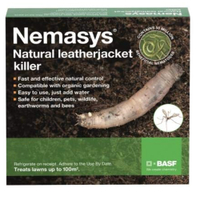How to get rid of leatherjackets in a lawn: garden experts share tips on stopping the grass-destroying pests
Is your grass looking a little sparse and dull? You could be dealing with a leatherjacket infestation and not even realise it


Keeping your lawn looking its best all year round can seem like an impossible task especially when nature is against you. This is why it's infuriating when you have to worry about pests like leatherjackets eating away at your hard work, and no we're not talking about the stylish statement outerwear.
Even when you follow all the essential summer lawn care tips and keep on top of watering and mowing your grass can fall victim to aggressively destructive pests. Similar to how you can get rid of ant nests in your lawn, knowing how to tackle the insects as quickly as possible is the key to protecting your beloved lawn.
Whilst you may have never heard of leatherjackets before now, they're becoming increasingly common, especially with newly built lawns and you might want to be prepared just in case they come for your lawn. We spoke to leading pest control experts for advice on how to get rid of leatherjackets in a lawn for good.
How to get rid of leatherjackets in a lawn
As you might not know how to even recognise a leatherjacket if you saw one never mind remove them from your lawn, you'll no doubt be more familiar with stopping daddy long legs coming into your house instead, we asked some garden experts for their advice and knowledge.
"Leatherjackets are the larvae of the crane fly, more commonly known as daddy longlegs, and they cause damage to lawns by feasting on the roots of the grass," explains Craig Wilson, Co-founder, director & in-house gardening expert at Gardeners Dream. "New-built homes are particularly susceptible to leatherjacket infestations due to the fresh turf often used in their gardens, which can become an ideal breeding ground for these pests."
When it comes to the pest control of leatherjackets, you won't be able to use eggshells in your garden as a deterrent as it will take something a little stronger.
Craig is quick to stress the importance of using preventative measures to keep the pests away from the beginning but should you find yourself with an already established infestation here are some things you can do to regain your lawn back.
Sign up for the woman&home newsletter
Sign up to our free daily email for the latest royal and entertainment news, interesting opinion, expert advice on styling and beauty trends, and no-nonsense guides to the health and wellness questions you want answered.
1. Use natural nematodes
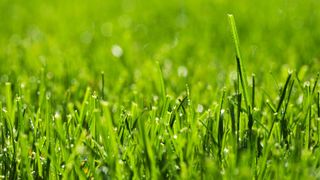
If you prefer more sustainable garden ideas, then using biological methods to remove leatherjackets from your lawn may be the best course of action.
Craig explains that one of the more effective ways to get rid of these lawn-destroying pests is to use nematods which are also environmentally friendly. He says, "These microscopic worms enter the leatherjacket larvae, infecting them and stopping them from feeding within around three days. Subsequently, the leatherjackets will die after about 14 days."
The nematodes then reenter the soil underneath the grass and continue the same process on any other lurking pests. This is a fast-acting natural way of removing unwanted critters from your garden and naturally lasts much longer than other pest control methods.
Craig does point out that leatherjackets are more vulnerable between late summer and early autumn, so he suggests this timeframe for tackling them with nematodes.
Nemasys Leatherjacket Killer nematode treatment, £17.40 at Amazon
Nemasys Leatherjacket Killer is a natural solution and is 'totally safe for children, pets and wildlife and the lawn can be used immediately after application.'
2. Manual removal
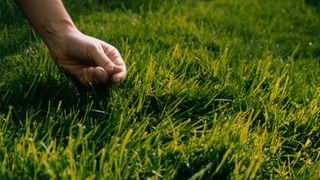
Unlike how to stop foxes coming into your garden, you can take a more hands-on approach to leatherjackets. Whilst it might not be on the top of your favourite garden tasks list, removing the larvae by hand can be surprisingly effective.
"For smaller or more manageable areas, physically removing leatherjackets by hand can be a simple yet effective method. It involves manually extracting the grubs from the soil, which can help reduce their numbers significantly," explains Craig.
Of course, make sure to wear protective gear and when it comes to discarding the pests, you can take a more humane approach and put them in a woodland far away from residential homes.
Homebase Protect & Grip Gardening Gloves: £4 at Homebase
These gloves are perfect for leatherjacket hunting, they're made from durable materials so they'll last year after year too. Their specialised gripped design is ideal for pest removal and weeding.
3. Aerate your soil
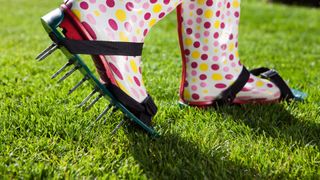
If you really want to keep it natural then aerating your lawn is a helpful trick for disturbing the leatherjacket's ideal environment. Aerating is also useful if you're wondering what to do if your lawn is yellow!
Speaking to Ryan, he explains that by aerating the soil in your garden you can improve the drainage which will bother the leatherjackets as they thrive in moist conditions. He says, "You should also encourage predators like birds to enter your garden by leaving areas with leatherjackets exposed to the elements."
Alongside aerating, Ryan also recommends regularly mowing the lawn as it will expose areas of grass whilst simultaneously disrupting the lifecycles of the pests. This method is the least disruptive and will be the healthiest option for your lawn, it won't however have the most rapid effect on the leatherjackets.
Knowing how often you should aerate your lawn is also important for keeping your grass looking its best.
GRÜNTEK Lawn Aerator Shoes, unisize: £21.85 at Amazon
There are endless benefits to regularly aerating your lawn, one of them being that it upsets the dreaded leatherjackets. These spiked aeration sandals on Amazon are adjustable and feature 13 steel nails to make your lawn more porous.
4. Chemical treatments

Similar to how you'd use insecticides as a way to keep ants away, you can choose to go the chemical route to rid your lawn of leatherjackets. However, most garden experts would argue that this should be a last resort due to the damage it can cause to other plant life, the environment and even yourself.
"Pesticides can be used as a last resort, but just remember to opt for environmentally friendly ones and try to use more ecologically sustainable methods first before you introduce these to your garden," says Ryan Fowley, a pest removal expert and COO at Excel Pest Services.
We especially don't recommend opting for the pesticide option if you're participating in the rewilding trend as this will more often than not damage any progress you've created with attracting native plants and wildlife to your garden.
FAQ
Can you prevent leatherjackets from coming back?
As mentioned previously, prevention is key with these types of pests. Craig says that maintaining a healthy lawn is the best defence against leatherjackets. So make sure you know how to keep your garden healthy while on holiday, you don't want to return to a swarm of unwanted guests.
"Whilst it might not completely deter them, regular aeration and the use of a high-quality feeding program can keep your grass robust enough to withstand and recover from leatherjacket damage,” he explains.
Not only is aerating your lawn a great method for getting rid of the larvae but it's also helpful with prevention too. Craig points out that aerating your lawn can be really beneficial in drying out your soil slightly, which makes it more difficult for eggs to hatch and for the larvae to thrive.
What are the symptoms of a lawn with leatherjackets?
Whilst you might not have spotted the leatherjackets themselves, there are some obvious signs to be found with your grass that will tell you immediately that you've got a pest issue.
"Identifying a leatherjacket problem early is crucial to preventing significant lawn damage. Look out for signs such as increased bird activity on your lawn or visible yellow patches. Both of these might indicate that there is an infestation beneath the surface," says Craig.
Phi Dang, garden expert and head of operations at Calibre Cleaning, says that easily uplifted grass is also a surefire sign of leather jackets. He explains that if your grass loosens and lifts easily, it's because the pests are eating away at your turf roots. He recommends regularly checking your lawn for any clear signs.
If you've avoided all the lawn care mistakes and are still seeing these signs then chances are that you've got a leatherjackets infestation. But by following the methods above you should be able to quickly get control of the situation and remove them before the damage is truly repairable.
If you're worried that you won't realise you have a leatherjacket problem until it's too late Phi suggests monitoring your lawn with traps. He says, "You can control the adult crane fly population by implementing light traps during early autumn. This assists you in monitoring the potential for leatherjacket problems as well as timing your treatments more effectively."
Hopefully, now you have all this knowledge on the grass-destroying pests, the only leather jacket in your life will be the one hanging in your capsule wardrobe.

Emily joined woman&home as a staff writer after finishing her MA in Magazine Journalism from City University in 2023. After writing various health and news content, she now specialises in lifestyle, covering unique cleaning hacks, gardening how-tos, and everything to help your houseplants thrive.
-
 I asked scientists about the best exercise for longevity - and they all said the same 3 workouts
I asked scientists about the best exercise for longevity - and they all said the same 3 workoutsWondering what the best exercise for longevity is? We've asked scientists, personal trainers, and doctors for the must-do workouts to live healthier for longer
By Grace Walsh Published
-
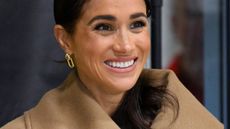 Meghan Markle gives sneak peak of 'understated luxury' kitchen - her Le Creuset favourites have our seal of approval
Meghan Markle gives sneak peak of 'understated luxury' kitchen - her Le Creuset favourites have our seal of approvalWith Love, Meghan gave fans an idea of what the Duchess of Sussex’s kitchen style is like and now we’ve had it confirmed in a sneak peek.
By Emma Shacklock Published
